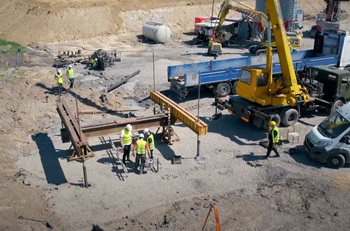Beneath the Build: Validating Innovation in Krakow
by Natalie Springfield, on July 11, 2025
It is always said in construction you must measure twice, cut once. Tensar believes validation matters, and that is why the team decided to test their advanced geogrid technology and design methods on a major infrastructure project in Krakow, Poland. In this episode of Beneath the Build, we explore the testing and validation of a mechanically stabilized layer with geogrid to solve the general contractor’s issues on this site.
.jpg?lang=en-US&height=295&width=350) Utilizing their detailed, research-based design methods Tensar’s technical team conducted a series of rigorous field experiments specifically for working platform applications where safety operations of construction machinery are critical. The team applied heavy loads to thin aggregate layers stabilized by Tensar's InterAx® geogrid, measured deformations and compared to theoretical calculations. The results validated Tensar’s design methodologies and product performance, particularly its geogrid solution meeting all the required safety factors.
Utilizing their detailed, research-based design methods Tensar’s technical team conducted a series of rigorous field experiments specifically for working platform applications where safety operations of construction machinery are critical. The team applied heavy loads to thin aggregate layers stabilized by Tensar's InterAx® geogrid, measured deformations and compared to theoretical calculations. The results validated Tensar’s design methodologies and product performance, particularly its geogrid solution meeting all the required safety factors.
.jpg?lang=en-US&height=231&width=350)
Over several months, Tensar partnered with academic and engineering institutions to construct full-scale test sections that mimicked actual road and rail weak subgrade conditions in areas where heavy construction machinery needed to operate. These sections were monitored and analyzed to verify how well Tensar geogrid performed in stabilizing soft soils, reducing aggregate requirements and increasing long-term pavement durability, safety of cranes and piling machinery operations.
For general contractors, this kind of data is more than just numbers. It’s proof that the solutions they rely on in the field are backed by extensive, repeatable research—offering greater confidence during bidding, design, and execution.
If you missed this week's episode of Beneath the Build, watch it now: Click Here
.jpg?lang=en-US&height=295&width=350) Utilizing their detailed, research-based design methods Tensar’s technical team conducted a series of rigorous field experiments specifically for working platform applications where safety operations of construction machinery are critical. The team applied heavy loads to thin aggregate layers stabilized by Tensar's InterAx® geogrid, measured deformations and compared to theoretical calculations. The results validated Tensar’s design methodologies and product performance, particularly its geogrid solution meeting all the required safety factors.
Utilizing their detailed, research-based design methods Tensar’s technical team conducted a series of rigorous field experiments specifically for working platform applications where safety operations of construction machinery are critical. The team applied heavy loads to thin aggregate layers stabilized by Tensar's InterAx® geogrid, measured deformations and compared to theoretical calculations. The results validated Tensar’s design methodologies and product performance, particularly its geogrid solution meeting all the required safety factors..jpg?lang=en-US&height=231&width=350)
Over several months, Tensar partnered with academic and engineering institutions to construct full-scale test sections that mimicked actual road and rail weak subgrade conditions in areas where heavy construction machinery needed to operate. These sections were monitored and analyzed to verify how well Tensar geogrid performed in stabilizing soft soils, reducing aggregate requirements and increasing long-term pavement durability, safety of cranes and piling machinery operations.
For general contractors, this kind of data is more than just numbers. It’s proof that the solutions they rely on in the field are backed by extensive, repeatable research—offering greater confidence during bidding, design, and execution.
If you missed this week's episode of Beneath the Build, watch it now: Click Here



